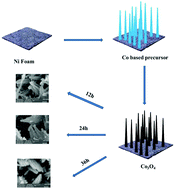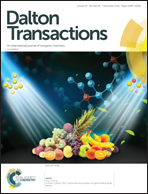3D hierarchical Co3O4@Co3S4 nanoarrays as anode and cathode materials for oxygen evolution reaction and hydrogen evolution reaction†
Abstract
With the increasing energy demand and environmental pollution, hydrogen production by water splitting is one of the best ways to solve the energy shortage. Three-dimensional (3D) hierarchical Co3O4@Co3S4/NF was first synthesized directly in situ, grown on the nickel foam through a simple hydrothermal process, and the anion-exchange reaction and the Ostwald ripening mechanism were investigated by adjusting the reaction time. The oxygen evolution reaction (OER) and hydrogen evolution reaction (HER) activities of Co3O4@Co3S4/NF-24 h were investigated, and the required overpotentials were 270 mV and 143 mV, when the current density was 100 mA cm−2 and 20 mA cm−2, respectively. Subsequently, the overall water splitting activity of Co3O4@Co3S4/NF-24 h was investigated; when the current density was 10 mA cm−2, the low cell voltage was 1.53 V, which, to our knowledge, was among the smallest values reported for electro-driven water splitting so far. This high catalytic activity is attributed to the construction of the O–S interface and the increased electron transfer rate at the beginning of the reaction. Through XRD, SEM and XPS characterization, it is proven that Co3O4@Co3S4/NF-24 h is relatively stable and is expected to be an efficient and stable water splitting catalyst.



 Please wait while we load your content...
Please wait while we load your content...